Smart toys
Documentation
Advance studio in progress.
Completed.
RISD ongoing advance studio
This is a regularly updated page about the advance studio I am currently taking. This blog will document the process of building a constructive, fun and innovative play experience. For reflections on readings and in-class experience please click the button below. For my partner charlie's website click below.

For the first day of the class, we were asked to form a group of 2-3 and make a model that represent one of our favorite toy from childhood. My group that consists of me grace and charlie decided we are going to reflect on this toy called TAMIYA 4WD, which is a self-assembled racer car. Below is a picture of the packaging.



Our approach.
Through building physical model
For this 30 minutes exercise, we built a mock up model that reflect our memories of this toy. We decided the plastic frame of the car is a crucial element that should be our main focus because it represents the hands-on process.


After a class discussion in which we critiqued our toy, we were told that our toy could be improved upon by including some customization capabilities. We then Incorporated more features presented in this info-graphic below.

In this exercise, we noticed how our area of interest expanded. We felt that it is necessary to encourage more peers social interaction through playing this toy because it is very solitary at the moment, despite that fact that it offers some education value in teaching children about mechanism and engineering. Through a class exercise using scratch and Lego-Wedo, we created a customizable, self-assemble and collaborative moon rover, which focus on promoting cooperation between peers. Below is a picture/video documentation of this project.




Here is the reflection right after the in class exercise:
Today in class we were asked to enhance our previous toys with Lego Wedo building blocks. Initially, I was skeptical of the idea since it is very hard to address the core feature of our design with Lego Wedo. But after letting go on some aspects of our previous design we developed a new toy that is centered around social interactions between playmates and teamwork. We designed a 3 wheel rover that has two wheels powered by motors, which twist in opposite directions. The goal of the toy/game is to move the rover towards the final destination of the mars through a collaborative effort with another friend, who gets to control one of the motor powered wheels. I actually enjoyed this experience because it lets us zoom out on the entire picture and see what value the toy brings instead of being too attracted to the technologies. I also realized the importance to trash the previous progress and start-over, and I think this is the best way to design a product that is actually good.
In class video:
The chassis of the car isn't design optimally, the two long motors on the side present itself to be too heavy and is often dragged on the floor as the car moves. A future design should incorporate a better turning system too.
Moving on to the next week after this Lego Wedo project, we were assigned to come up with a persona and then create a play experience that can be visualized through the format of a short video. We were given the option to work on a completely new idea or to enhance an old one. Charlie and I decided we like parts of the Bopit-racing experience and thus decide to create a new game with some of the take away we learn from the previous three projects. Charlie and I wanted to create a few personas that represent someone who would be interested in our previous games. We try to imagine what kind of shortcomings these people would have and then come up with a game that still resembles many elements from the previous toys, but adds more value in other areas such as collaboration. Below are three personas we identified as someone who would benefit from our future game.




After identifying the persona, we designed and illustrate this new game called Ballbit-racing adventure, which is about a game that places an emphasis on collaboration and teamwork. The game's mechanics is simple: two to four players control unique cars of their own racing through a series of obstacles in order to reach the finish line. Players must work in conjunction with one another since every car must park at the finish line for the team to win. bellow shows a picture collection of the game.











Trailer video:
The following video is a short trailer for our game.
In this video, we used a series of real-life interaction to representation what it would feel like to play Ballbit racing adventure. Mechanisms and gameplay in this video are demonstrated through life action to further emphasize the importance of cooperation and communication.
Ballbit-racing adventure 2.0
After listening to the feedback on Ballbit racing adventure, we realized that the story element was a big part that made the viewers identified with. Additionally, We realized that both the customization of the cars, along with the track must topics that need further development. After critique that day, the students were given a set of preprogrammed toys for further prototyping of the previous toy concept. Charlie and I had our eyes on a toy called Sphereo, which is a controllable ball that suits the purpose of the direction we want to go next.
Ballbit-sphero prototype.
Ballbit-sphero prototype adjusted.
For the class for the following Thursday, we had a chance to consult Stefania's designer friend, Hannah who often makes toys for her own daughter. Hannah told Charlie and me that she very much enjoyed the story-telling component of the project too, but she felt that there needs to be an actual story that goes with the game. She explained that many popular action figure toys are popular, not entirely because they look cool or is fun to play with, but rather they have a unique story of their own the sparkles more imagination within a child. Similarly to our previous feedback, Hannah also suggested that we need to incorporate more customization capabilities into our toy for a better play experience
Ballbit-racing adventure 2.0 Prototypes.





We continued Ballbit adventure 2.0 development by building a series of semi-playable levels with foam core. These levels require close cooperation between two players to complete, and there are specific casings, designed specifically for each level. The goal for this round of prototyping is to figure out what the play experience is like for each level. Below is a series of videos showing how each prototype is played.
With these quick prototypes, we figure out the general system for our levels: each level needs to contain at least two floors, one for obstacles, one for resting the Ballbits (Sphero). We wanted these levels to stack on top of each other since moving from the bottom to the top seems to be a more logical advancement. With the general structures figure out, we decide its time to build a more refined working prototype. We used Solidworks to map out the dimensions of each level and use them as a template to cut the plywood.





We used 0.25 inches birch plywood to construct this prototype. He are some wood working process we went through.



Ballbit adventure 2.0 user test.
We invited our peers to test out the three levels we built so far and received much constructive feedback on how to improve the overall play experience. The general reaction to our game thus far has been positive.



Our next version of Ballbit adventure will focus on making the play experience more smooth and easy since difficulty and consistency was a major problem that emerged from our user testing. We will make the levels more open, thus allowing more room for customization. We also imagine the use of transparent materials for our next design in order to improve user perception of each level. Below is a collection of renderings that shows the incorporation of transparent materials. These images do not represent the final design.

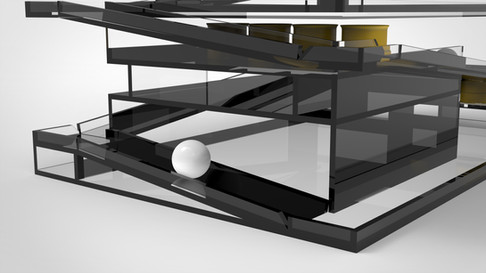





Despite this vision, we felt we are not ready to jump right into acrylic or any other transparent materials yet, instead, we decided to use foam core as it can be easily modified. Here is a list of things we wished to change:
Ballbit 2.0:
Levels too hard
Wood
Lacks customization
Ballbit 3.0:
Arduino mechanism to reduce the difficulty
Foam core
Levels will be modulized
Ballbit adventure 3.0
After noticing that there are many dead-end situations that require hand adjustment, we felt that we need to provide the user with enough tools so that they would always have a way to continue the game without using their hand for reset, and this requires mechanical movements. To address this problem, we introduced a few Arduino powered mechanism to make the overall gameplay more automated and hands-free. The top left corner is a potentiometer powered fliper, which can reset the orientations of the casing. The top right corner is a stepper motor powered elevator, which can carry the Sphero to the next floor.
Top left is a release mechanism for a new bridge attachment we developed. Top right shows how we putt everything together.
This video shows our testing of the arduino enhanced prototype that were made with foam core.
Playtest 3.0: Lexington Montessori School
We asked the students at Lexington Montessori school to test out our prototypes!

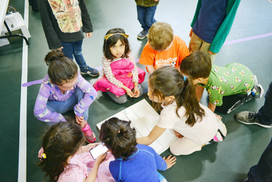
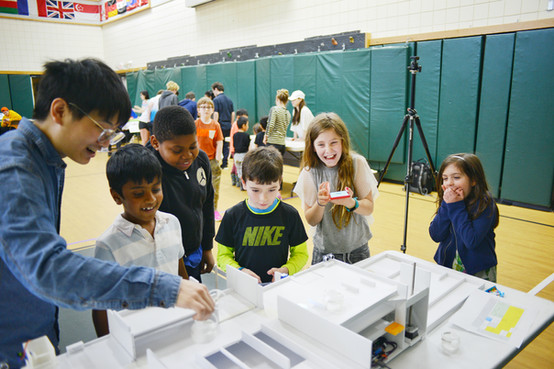
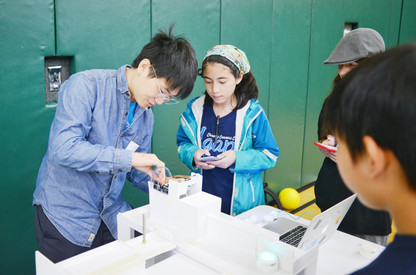

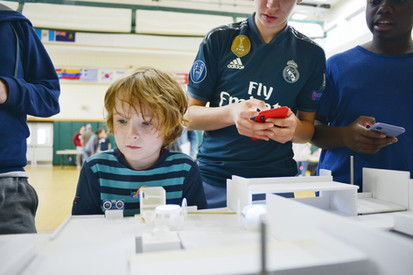

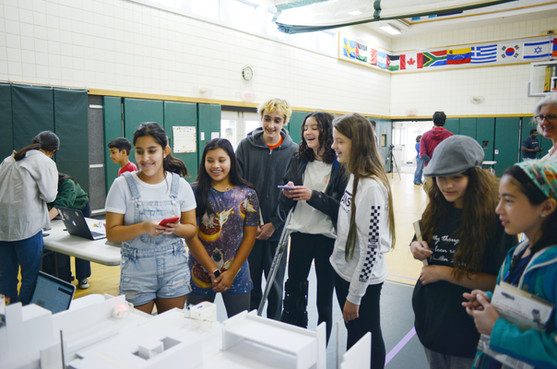
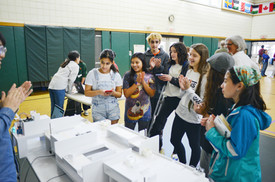

User testing video:
From the feedback, we got from the user test, we narrowed down to three main improvements we need to incorporate into the next generation of Ball bit adventure:
Ballbit 3.0:
3 floors
Foam core
White outlook
Ballbit 4.0:
2 floors
Acrylic
Color incorporated
Ballbit adventure 4.0
Final prototype for Ballbit adventure.








